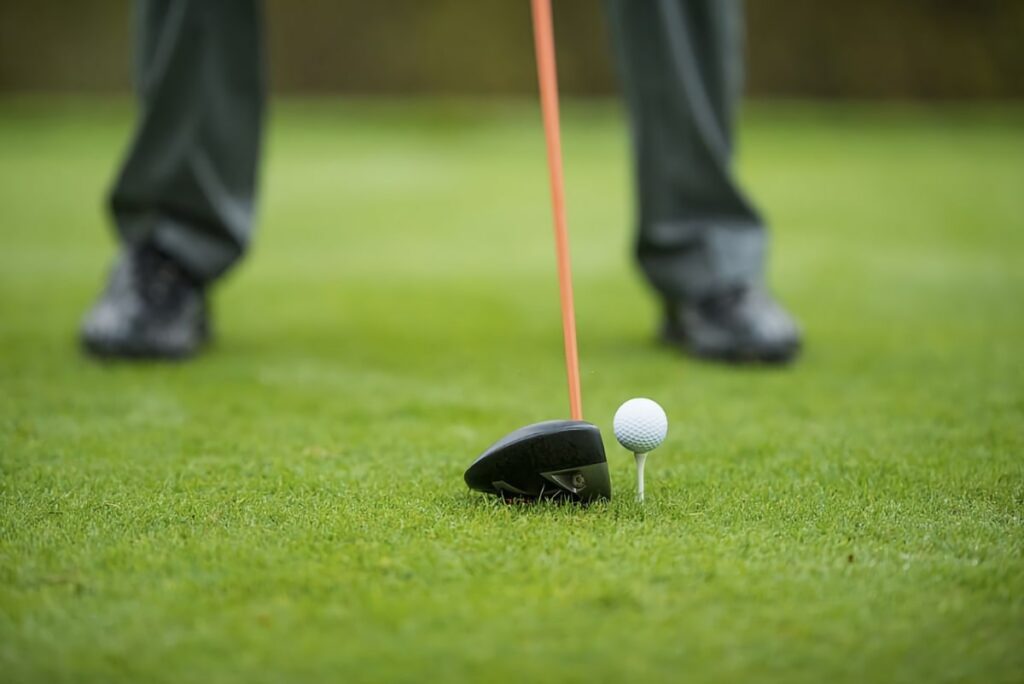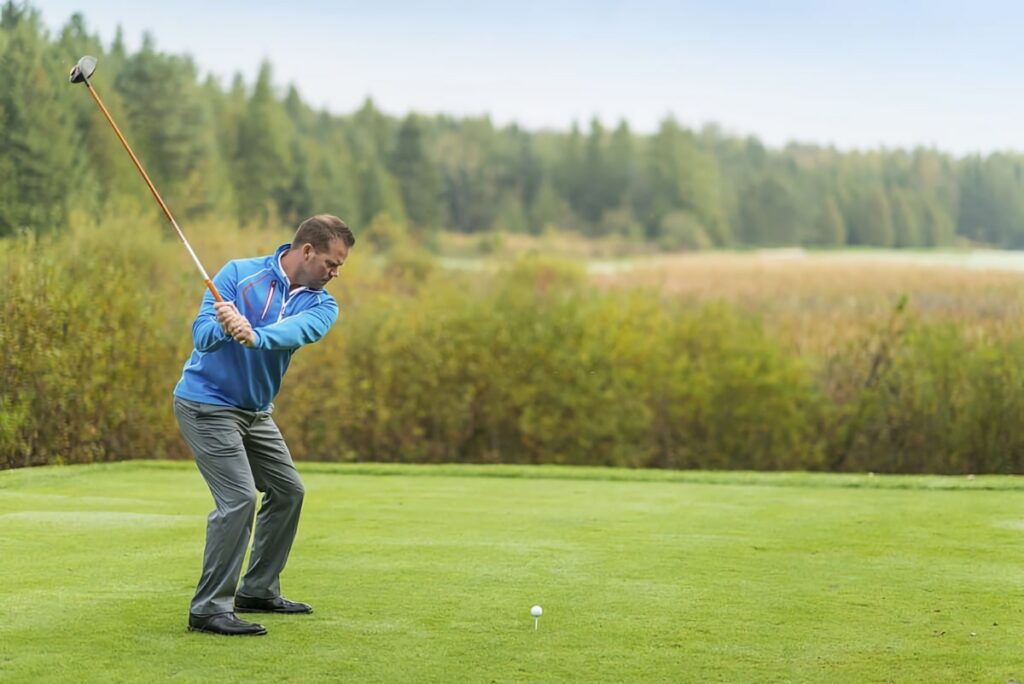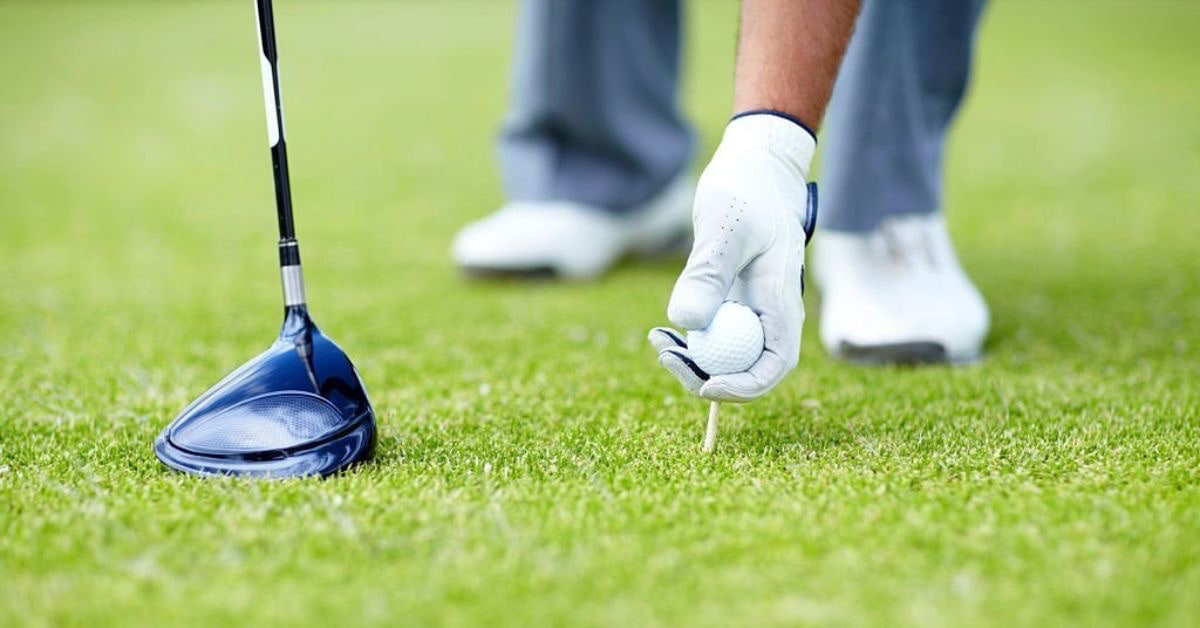In golf, a solid tee shot can put you in a great position on any hole. Unfortunately, the driver can often be the hardest club to hit for many amateur golfers.
The driver swing differs from your typical iron or wedge swing. Instead of hitting down to compress the ball, you should aim to hit upwards for optimal launch and distance.
In this article, you’ll learn 5 simple tips on how to hit a driver. Also, I’ll discuss how to hit low tee shots into the wind, and how to hit a driver off the deck — if you dare try!
How to Hit a Driver
To hit a driver, it’s vital to strike the ball with an ascending attack angle. Put simply, this means teeing the ball up high and forward in your stance. Then, with slight upper body tilt, swing so that the clubface travels upwards into the ball for optimal launch and distance.

Here are 5 simple tips on how to a driver off the tee:
- Tee height — Ball equator in line with the top edge of the clubface
- Ball position — In line with the inside of your front heel
- Width of stance — Inside of your heels shoulder-width apart
- Upper body tilt — Slight tilt creates an upward angle of attack
- Width & balance — Wide takeaway with balanced follow-through
If you’re struggling to hit your driver consistently, it’s likely that you’re falling short on one of these. So, let’s dive into the details!
Step 1: Tee Height
If you want to hit your driver well, it’s vital that you tee your ball at the correct height.
Ideally, the ball’s equator should be in line with the top edge of the driver’s face.
To achieve the best distance possible with your driver, the aim is to strike up on the ball with an ascending angle. Teeing the ball high enough increases the launch angle, which enables the ball to travel further in the air before returning to the ground.
Also, many golfers suffer from hitting driver low on the face. Usually, this is caused by a low tee height. Low face impact equals higher spin rates, which reduces distance.
Ultimately, you should tee the ball relatively high with the driver. This will help you hit upwards into the ball, optimizing launch angle and spin, and maximizing distance.

Step 2: Ball Position
Next, it’s important to position the ball correctly for optimal distance.
With driver, the ball should be positioned in line with the inside of your front heel.
This allows the club head to bottom out before reaching the ball, which helps to achieve an upwards angle of attack into the golf ball — optimizing the launch angle.
The setup is simple. First, address the ball with your feet together. Then, take a tiny step to the left with your lead foot, and take a big step to the right with your trail foot.
PRO TIP: Flare your lead foot out slightly to allow for more rotation through the ball, maximizing speed and distance.

Step 3: Width of Stance
Another essential component of the driver swing is having a wide stance.
Put simply, the inside edge of your heels should be in line with your shoulders.
This helps create a stable base, which allows you to rotate through the driver swing while keeping your head still. Ultimately, this will improve your ball striking.
Step 4: Upper Body Tilt
To promote an upwards motion into the ball, it’s useful to have an upper body tilt.
When addressing the golf ball, slightly tilt your upper body away from the target.
Put simply, if you were to draw a line from your belt buckle to the center of your chest, the line should have a slant and be angled away from the target.
Essentially, this encourages you to strike up against the golf ball for optimal launch.

Step 5: Width & Balance
Finally, you need to have width and balance in the driver swing.
In the takeaway, extend your arms away from your body to increase width.
A wide takeaway increases power in the driver swing by encouraging the upper body to rotate and coil into the top of the swing, maximizing distance.
Likewise, extend through the downswing and maintain balance in the finish position.
Check out the informative video below by Rick Shiels, where he demonstrates the essential steps on how to hit a driver long and straight:
FAQs
Here are a few handy answers to common driver queries:
How to Hit a Driver Longer
To hit your driver further, you can improve three components of the swing:
- Launch angle
- Strike location
- Club head speed
Firstly, you can optimize the launch angle. To do this, position the ball further forward in your stance and make sure you’re striking upwards into the ball. This ensures the swing bottoms out in front of the ball, striking the ball at an ascending angle.
Another way to hit your driver longer is to improve your strike location on the clubface. If you can consistently strike the ball with the center of the face, your driver ball speeds will increase and your tee shots will carry further.
Lastly, you can simply work to increase your club head speed. One way to achieve this is to improve your flexibility and rotate more through the driver swing. In addition, you can try using a longer and lighter driver shaft — both of which will increase speed.

How to Hit a Driver Low Into the Wind
To hit a driver low into the wind, you can lower the tee height and move the ball position closer to the middle of your stance. This will reduce the launch angle, and keep the ball flight lower to prevent the ball from getting held up in the wind.
It’s best to avoid high-launching shots in windy conditions as you lose a large amount of control over the ball. Essentially, your ball is in the hands of the wind!
Also, if you apply too much spin to the ball in windy conditions — whether vertical or horizontal — the spin will be exaggerated by the opposing wind direction. This can cause massive loss of distance, and frustratingly big driver hooks or slices.
Therefore, it’s important to make good contact with the ball. This means striking the ball as close to the center of the clubface as possible. This will reduce spin, resulting in a more “punchy” tee shot that can pierce through the wind.

How to Hit Driver Off the Deck
To hit driver off the deck, move the ball further back in the stance than when hitting the driver off the tee. Slightly flare out the lead leg, and put slightly more weight onto your front leg. Then, hit more down onto the ball, grazing the turf beneath it.
Due to the nature of the downward motion, you’re more likely to play a slight fade when hitting this shot. So, aim slightly left, and feel as though you’re cutting across the ball at the point of impact. This will help you pull the club head through the ball.
While driver off the deck is one of the rare shots in golf, it can be a valuable skill to have in your locker for reaching par 5’s from around 300 yards.
Conclusion
In summary, to hit a driver you want to hit upwards into the ball to optimize launch angle and spin rates — which work together to maximize distance off the tee.
To do this, follow these 5 simple tips:
- Tee height — Ball equator in line with the top edge of the clubface
- Ball position — In line with the inside of your front heel
- Width of stance — Inside of your heels shoulder-width apart
- Upper body tilt — Slight tilt creates an upward angle of attack
- Width & balance — Wide takeaway with balanced follow-through
Ultimately, the driver swing differs greatly from the typical golf swing used for the other clubs in your bag. Rather than hitting down on the ball, you want to hit upwards.
Your goal is distance and accuracy. So, focus on giving yourself the best possible chance to launch the ball off the tee, setting yourself up for the hole ahead!


